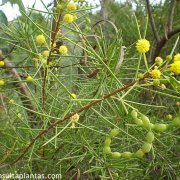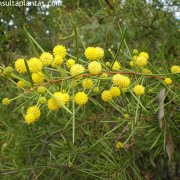Care of the tree Acacia tetragonophylla or Kurara |
|
The Acacia genus, of the Fabaceae family, includes some 1,200 species of shrubs and trees native to Australia, Africa, Asia and South America. Some species are: Acacia tetragonophylla, Acacia saligna, Acacia paradoxa, Acacia melanoxylon, Acacia luederitzii, Acacia longifolia, Acacia karoo, Acacia iteaphylla, Acacia greggii, Acacia dodonaeifolia, Acacia dealbata, Acacia cultriformis, Acacia hebeclada, Acacia tortilis, Acacia truncata, Acacia pendula. Common names: Curara, Dead finish o Kurara. This species is native to western Australia. They are short-stemmed shrubs or small trees that tend to branch from the base and reach 5 meters (16.40 feet) in height. The leaves are rigid, linear and have a thorny tip. The yellow flowers appear in globose inflorescences. They bloom in winter and spring. From the pod-shaped fruits you can get seeds for reproduction. Curara is often used to fix dry slopes or to form windbreaks and informal hedges. They are ideal for Mediterranean coastal gardens. Acacia tetragonophylla needs full sun exposure and a dry and warm climate. They have good frost resistance. Dead finish can grow in any type of well-drained soil, whether sandy, calcareous, stony, clayey or poor. Kurara has a high resistance to drought so they will be watered moderately in spring and summer. Always wait until the soil has completely dried. Fertilizer is not required. Kurara can be pruned a little after flowering to control their growth. Acacia tetragonophylla is plant resistant to the usual pests but sensitive to excess watering. Propagation is simple from seeds sown in spring. It is advisable to immerse them a few seconds in boiling water and leave them to soak overnight in warm water. |
Images of the tree Acacia tetragonophylla or Kurara |
Find plants
Acacia tetragonophylla or Kurara | Care and Growing
© 2025 FavThemes

